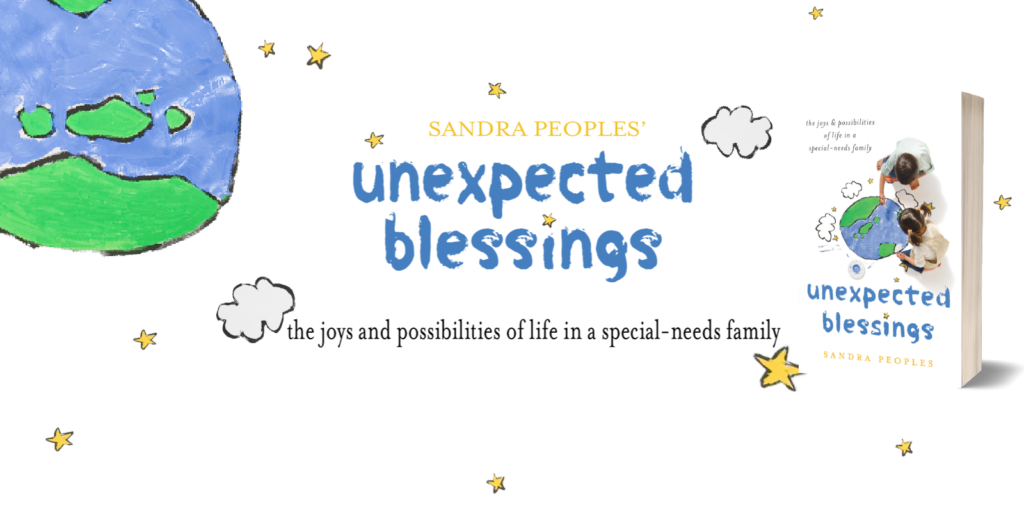5 Phases of Special-Needs Parenting are based on my book, Unexpected Blessings: The Joys and Possibilities of Life in a Special-Needs Family. This post provides an overview, and there’s help and encouragement for parents in each stage in my book.

I grew up in a special-needs family. When we got James’s autism diagnosis in 2010, I knew where to turn for advice—my own parents. Based on our experiences, their experiences, and the experiences of those around us, I noticed a pattern in the lives of special-needs families. That pattern is what I call the 5 Phases of Special-Needs Parenting.
We don’t all move through them at the same rate. Some of us can get stuck in phase 1 or 2 and not be able to move through. When I wrote Unexpected Blessings, I did so with some specific friends in mind. A few of them are stuck in phase 1. And they are different ages—one close to my age and two with children in their late teens. The age of your children doesn’t determine which phase you’re in. Their diagnosis doesn’t determine your phase. How you allow God to work in you and through you is what determines your phase.
Like our family, I hope you can move from a place of pain to finding your purpose. It wasn’t always easy. In fact, my husband and I didn’t move through the phases as the exact same pace. We had to be patient with each other and show grace.
As we look at each step, think about where you are and where God wants to take you in the future. There’s no rush. Each phase is important. But I hope you see the joys and possibilities that await you through the phases!
Phase 1- Recognize Plan B
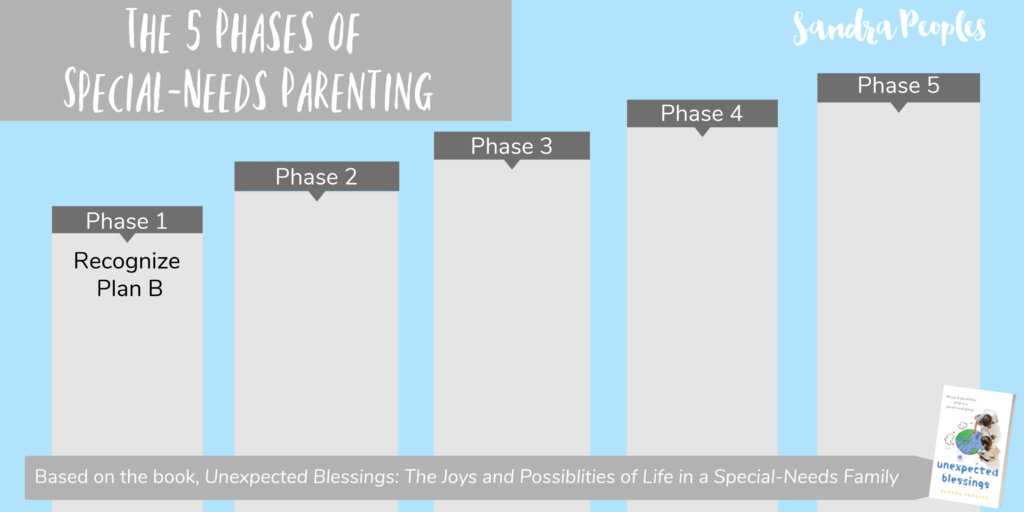
No matter when you heard a diagnosis for your child, it was a surprise. James’s diagnosis came when he was 3 years old. My sister’s diagnosis came as soon as she was born, two days after Christmas in 1977. Even if you adopted your child, his or her file couldn’t include every detail of who your child is or will become. We all find ourselves in a plan B situation in phase one.
The words that best describe phase 1 are confusion, disappointment, anger, and depression. We all react in different ways. In my book I have a chapter on the stages of grief I think we all go through. What I think is important to remember is that we don’t need to ignore what we’re feeling. The Holy Spirit works in our lives to give us hope no matter how deep in sorrow we feel. We can be honest in prayer with God and honest with others who can provide help.
But the diagnosis that surprised us did not surprise God. At times we may feel forgotten or ignored by Him, but that isn’t true. He is with you! After James’s diagnosis there was a time I repeated to myself each day “God loves me; God loves James.” I knew I was close to the end of phase 1 when I believed it each time.
Phase 2: Recover & Rebuild Rhythms
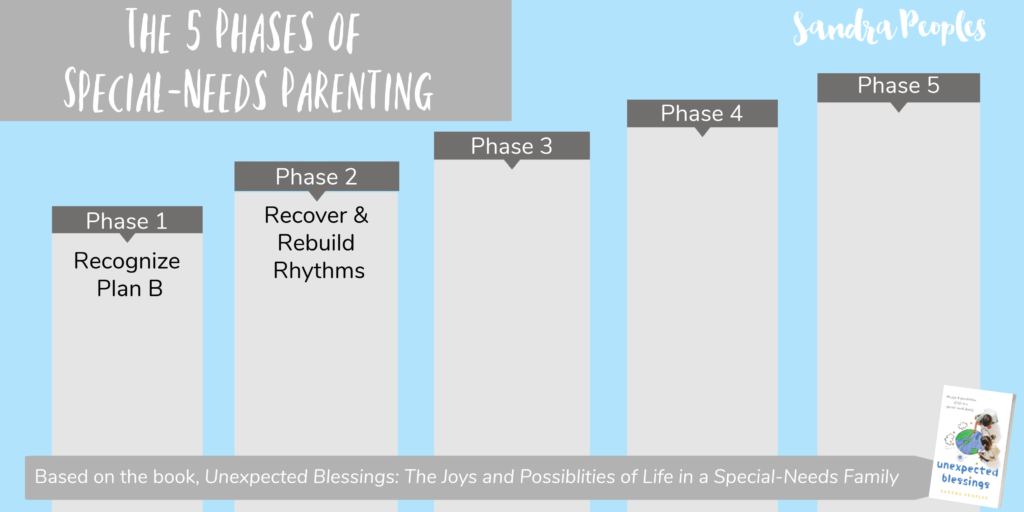
One you accept Plan B, you develop a new normal. In this phase you focus on self-care and rebuilding rhythms that work for your family. This process may take a while. And you may revisit it if you have a child who is medically fragile or goes through a stage (like puberty) that causes big changes for your family. There’s lots of practical help in my book and even on Pinterest to create strategies that work for you family, but here are the big three that have helped me.
- Learn to say no. I focus on what only I can do and say no to what others can do when I’m in a season of feeling overwhelmed. For example, someone else can grocery shop for me. I pay a small fee to pick up my groceries at the store. You may have to say no to good things, but that frees you up to say yes to the best things.
- Eliminate decision fatigue. Many of the decisions we make each day are repeats. When we set those on autopilot, we have the captaincy to really focus on what’s important. For example, I wear the same shirt every Monday. I don’t have to think about what I’ll wear because the decision has been made. We have hamburgers every Saturday. So every Saturday morning I know to lay out ground beef to thaw.
- Establish household routines. I’m talking about cleaning and meal planning routines here. You may have to experiment to figure what works best, but each routine you can establish will be a big help!
Phase 3: Reinforce Your Faith Foundation
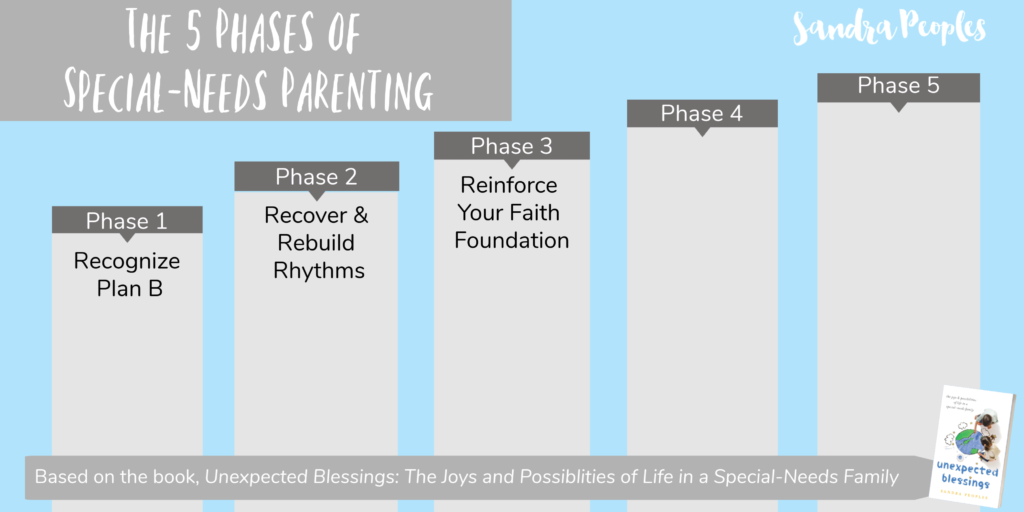
Hearing a diagnosis for your child changes everything. And that can include your view of God. If you had unintentionally believed that God would punish you if you did wrong and reward you if you did everything right, you may see your situation as a punishment. But that’s not how God sees disabilities. In phase 3, you’re working to reinforce your faith foundation. And when the next storm hits, it will stand with strength.
The passages I use to develop my theology of disability include:
- Psalm 139– We are all fearfully and wonderfully made
- Exodus 4:11– God allows disabilities for His purpose. He said to Moses, “Then the Lord said to him, “Who has made man’s mouth? Who makes him mute, or deaf, or seeing, or blind? Is it not I, the Lord?
- John 9– Jesus Himself said that disabilities exist so “that the works of God might be displayed …“
Once we understand how God sees our family members with disabilities, we can see Him more clearly and experience His love more deeply.
Phase 4: Renew Relationships

In this phase, you work to strengthen the relationships you have.
- With your spouse
- With your typical children
- With extended family and friends
- With your church family
Each relationship is important. I’m especially sensitive to the needs of special-needs siblings because I am one. In the book I give advice for how to support and encourage the typical kids at your house. Most of our family members are supportive, but I know that’s not the case for many families. We can look at the example of Christ and how He responded to the people around Him who just didn’t get it at times. He continued to be patient and explain the truth. Because we moved to our new town last year, our friends and church family are still getting to know us. But we open up our home and invite people over as often as we can so they get to know us and James. All these relationships take time and attention!
Phase 5: Reach Out to Others
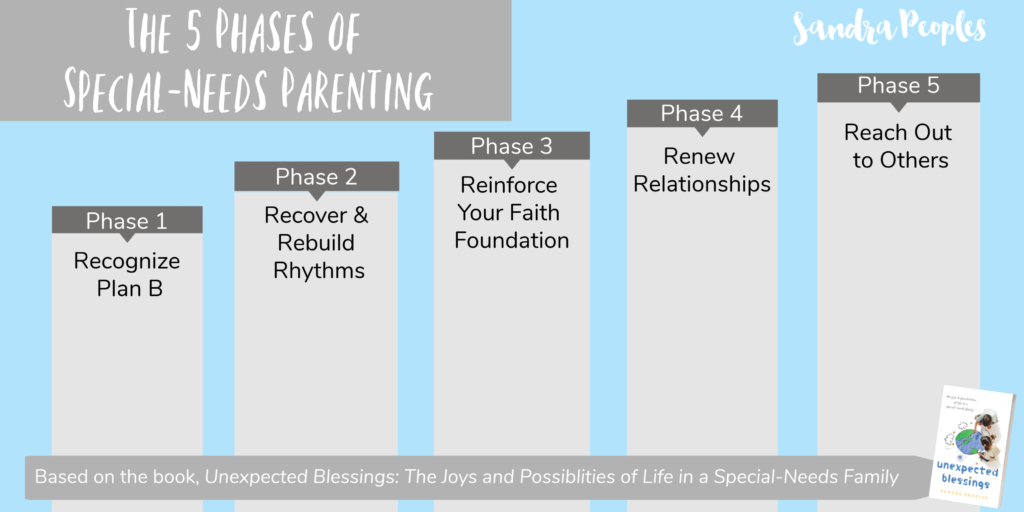
Phase 4 and phase 5 have a lot of overlap. You will still be investing in relationships with those close to you as you look outside your circle to make a difference for others. In the book I include stories from three individuals who made a difference in the world, their state, and their local community by being obedient to what God had called them to do. My husband and I are passionate about special-needs ministry. We support the work Key Ministry does to make sure every child is welcome in a local church home. Your calling could be working toward insurance reform, leading a support group, starting an after-school program, or providing help navigating your local school district’s special education system. The possibilities are truly endless because God will do something with you that He would never do with me.
Make a positive difference in the life of one other family by using the gifts and knowledge God has given you. And if you feel led, make a difference for another family or for a larger group of families. Don’t waste your family’s experiences. God won’t waste them.
I hope you find these phases helpful as you look at your own journey! Remember, your Plan B is still God’s Plan A, and He will walk with you each step of the way.
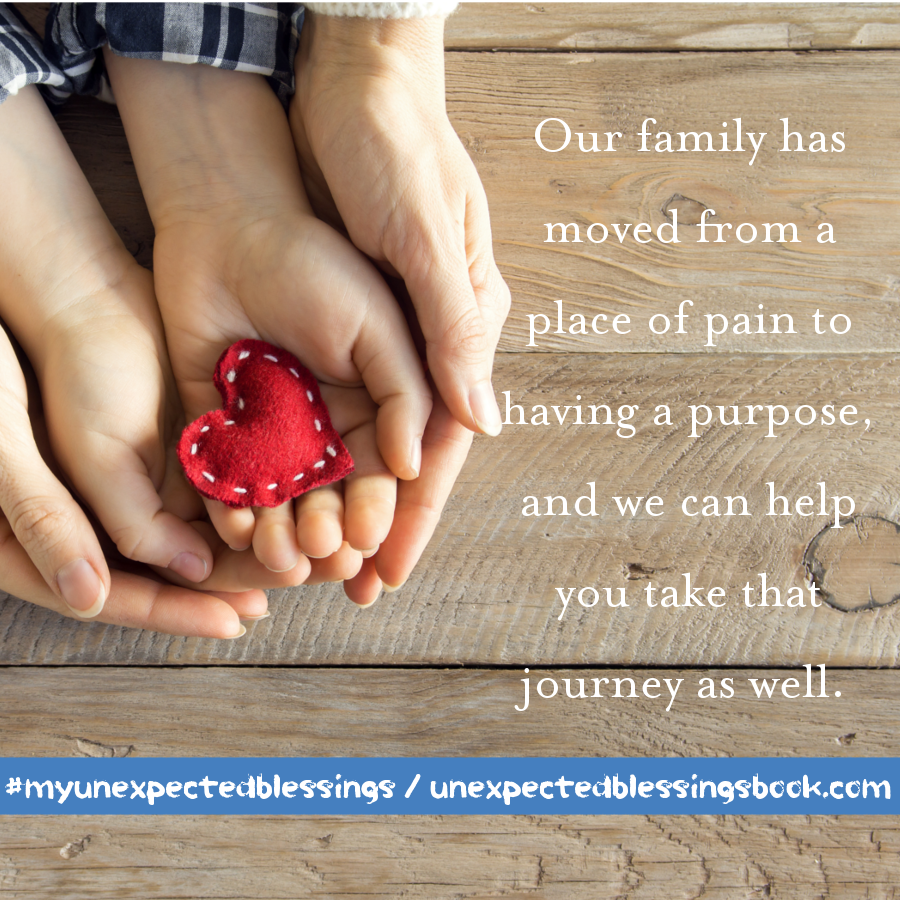
Please don’t copy the stages or accompanying information with out written permission from me.

